Share your phone number with us, we'll call you!
Share your phone number with us, we'll call you!
How is gum contouring in Turkey performed?
Share your phone number with us, we'll call you!
The goal of gum contouring in Turkey is to improve the smile's aesthetics by reshaping the gum line. Gum contouring is known as gingivoplasty or gingivectomy. The treatment addresses issues such as uneven gum lines, extra gum tissue, or gum recession . Its goal is to establish a balanced and pleasing gum line, resulting in an improved appearance.
Gum contouring in Turkey holds significant importance for individuals seeking to enhance the symmetry and balance of their smiles. The elective procedure is commonly pursued for aesthetic reasons, especially in cases where individuals feel self-conscious about a "gummy smile" or uneven gums . Gum contouring in Turkey contributes to oral health by lowering the chance of gum disease and improving the harmony between the gums and teeth beyond its cosmetic benefits.
Gum contouring in Turkey is performed using either a soft-tissue laser or an electronic dental drill. The dentist carefully sculpts the gum line, removing excess tissue or reshaping the gums to achieve the desired appearance. Gingivoplasty minimally invasive procedure is known for its precision and effectiveness, and the results are seen in the gum contouring before and after images, showcasing the transformative impact on the smile.
Dentists recommend gum contouring to patients in Turkey facing aesthetic concerns such as an uneven gum line, excessive gum tissue covering the teeth, or cases of gum recession. Individuals with oral health issues, such as susceptibility to gum disease due to uneven gum surfaces, benefit from gum contouring in Turkey. The decision to undergo gum contouring in Turkey is collaborative, involving discussions between the dentist and the patient regarding their cosmetic goals and oral health needs.
Gum contouring in Turkey offers advantages and disadvantages for individuals seeking aesthetic improvement or addressing specific oral health concerns. Gum contouring in Turkey provides aesthetic enhancement by reshaping the gum line, leading to a more visually appealing and balanced smile. The procedure for gingivectomy in Turkey contributes to improved oral health by reducing the risk of gum disease and promoting better oral hygiene. One notable advantage is the minimally invasive nature of gum contouring, as it is a quick procedure with a relatively swift recovery period.
There are considerations on the downside. One of the notable disadvantages is the gum contouring cost, which is deemed an optional out-of-pocket cost. Costs vary, and individuals must be prepared for potential financial implications. Some patients experience mild discomfort or swelling after the procedure, although the effects are just temporary. Gum contouring in Turkey is not deemed medically necessary, and dental insurance does not cover the expenses.
Individuals contemplating gum contouring must carefully weigh the aesthetic and oral health benefits against potential costs and temporary sensitivity. Gum contouring in Turkey is an elective procedure, so patients must think twice about what they want out of it before deciding to have it done.
Gum contouring in Turkey, known as gum reshaping or tissue sculpting, is a cosmetic dental procedure designed to improve the appearance of the gum line and enhance a person's smile. People who are dissatisfied with the appearance of their gums, particularly when smiling, seek gum contouring treatment .
Gum contouring in Turkey is performed using advanced techniques such as radiosurgery, laser technology, and scalpels. The procedure begins with the dentist using a special pen to mark a new gum line, allowing the patient to visualise the changes that were made. Local anaesthesia is applied to numb the area, and in some cases, the removal of bone at the front of the tooth's root is necessary for optimal results. The excess gum tissue is precisely removed to create a more even and aesthetically pleasing gum line.
Diode lasers are commonly used in Turkey for gum contouring due to their efficiency. The lasers provide a faster, simpler, and less painful method for cutting away excess gum tissue and sculpting a more uniform gum line. One of the advantages of diode lasers is that they cauterise as they cut, leading to reduced bleeding and a lower risk of infection for patients.
Suitable candidates for gum contouring in Turkey are individuals who are in good health, mentally and physically, with healthy gums and teeth, and aged 18 or above. Patients are advised to stop smoking two days prior and maintain proper oral hygiene by brushing and flossing their teeth before the procedure.
Patients are advised to stick to soft foods and stay away from spicy or seedy things for a few days following their gum contouring treatment. They must take any prescribed medications and follow the dentist's instructions on post-treatment oral care.
The risks associated with gum contouring treatments in Turkey are minimal but include the slight chance of excessive bleeding, swelling of the gums, or allergic reactions. Skilled dental specialists carefully manage the risks to ensure the patient's safety and well-being.
Patients in Turkey learn about their treatment options and the risks and benefits during their first appointment. The gingivoplasty in Turkey, which takes around an hour, allows patients to return to their activities or explore the city after a day of rest. Follow-up appointments are scheduled to assess the healing process and make any necessary adjustments.
Gum contouring in Turkey provides individuals with an opportunity to achieve a more confident and aesthetically pleasing smile through a safe and advanced dental procedure. Gum contouring in Turkey aligns seamlessly with smile design principles, ensuring that every patient’s smile is not only healthy but also balanced and aesthetically appealing.
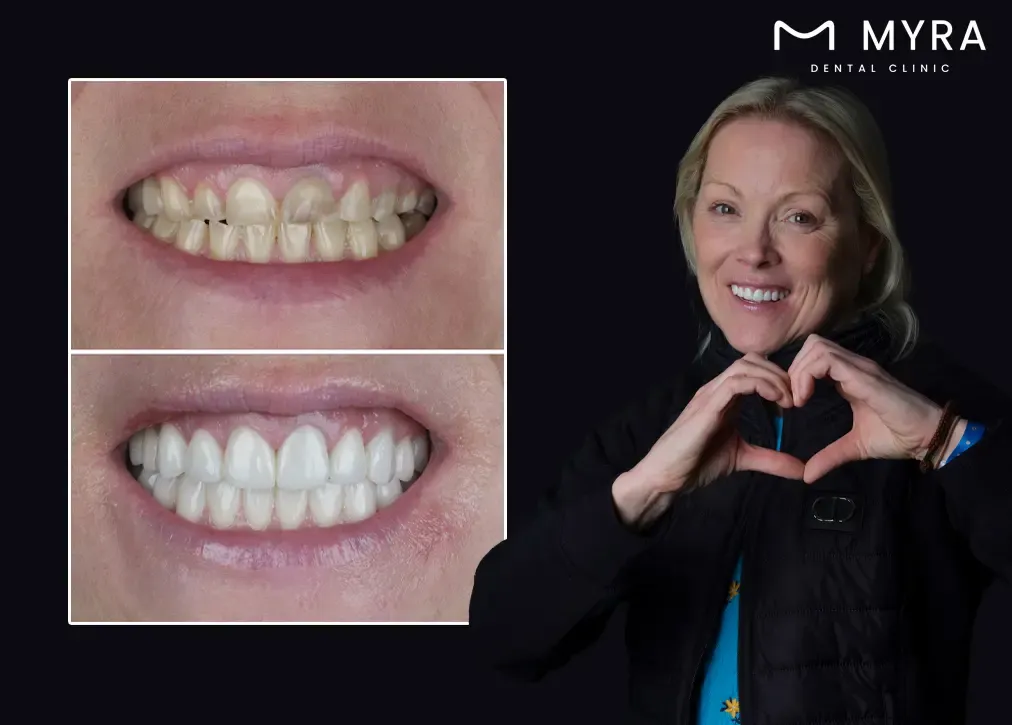
Gum contouring in Turkey works to alter or modify the gum line, aiming to boost the aesthetics of the teeth, gums, and smile. The process involves cutting away or removing excess gum tissue around the teeth. The procedure includes restoring gum tissue to achieve a more balanced and visually appealing gum line.
The process begins with an evaluation by a dental specialist who is a peridontist in Turkey. The dentist assesses the patient's gumline and discusses their aesthetic goals during the consultation. The dentist marks the new gum line using specialised tools, such as a special pen. It allows the patient and the dentist to visualise how much gum tissue is removed and how the reshaped gum line appears. A local anaesthetic is applied to numb the area before the actual contouring begins. It ensures that the patient experiences minimal discomfort during the procedure.
The excess gum tissue is precisely cut away or removed. The dentist repositions and restores the gum tissue in cases of gum recession, resulting in a more balanced and harmonious gumline. Gum contouring is performed using advanced techniques such as radiosurgery, laser technology, or scalpels in Turkey. Diode lasers are commonly used due to their efficiency in cutting away excess gum tissue while simultaneously cauterising to minimise bleeding. Patients are provided with post-procedure care instructions after the gum contouring procedures. It includes recommendations for soft foods in the initial days, avoidance of certain foods, prescribed medications, and specific oral care practises during the healing process.
The purpose of gum contouring in Turkey is cosmetic, focusing on improving the visual appearance of the gums, teeth, and smile. The goal of the procedure is to achieve a more harmonious gum line by repositioning receding gums or getting rid of extra gum tissue. The procedure makes the teeth look better and gives them a nice smile.
The majority of patients in Turkey opt for gum contouring for looks, but there are some cases where the dentist advises the procedure for proper oral health. Excessive or uneven gum tissue has the potential to contribute to oral hygiene challenges or be linked to some dental issues. Gum contouring in Turkey is suggested as a part of an all-encompassing treatment strategy that addresses health and gingival aesthetic considerations.
Gum contouring is important in Turkey because it serves as a pivotal procedure that addresses oral health and aesthetic considerations. The technique known as gum reshaping is carried out by specialised dentists across the country, showcasing a commitment to comprehensive dental care.
The procedure of gum contouring in Turkey is an indispensable part of achieving a natural, healthy, and aesthetically pleasing smile. Healthy gums, characterised by being light pink, tight, and well-adhered to teeth and bone at the appropriate level, contribute significantly to the ideal relationship between teeth and gums. The ideal relationship is the focus of gum contouring, making it a crucial component of achieving pink aesthetics in smile aesthetics.
The practise of gum contouring in Turkey is situated within a more comprehensive framework of oral health, in addition to the aesthetic benefits it offers. Gingivectomy in Turkey is not seen as an isolated cosmetic smilemakeover but rather as a form of treatment that addresses changes and arrangements in the colour and structure of the gums. The procedure is approached holistically, with an initial focus on ensuring gum health through proper treatment.
Gum contouring in Turkey is particularly important in cases of gum recession, where the procedure works to restore gum tissue and prevent tooth loss. The treatment aims to eliminate existing gum problems , ensuring that any aesthetic enhancements are built on a foundation of healthy gums. The success of aesthetic smile design is contingent upon addressing tooth and gum-related issues.
The procedure in Turkey is applied at different stages, including regenerative processes, gingivectomy, gingivoplasty, and crown lengthening. Individuals seeking personalised dental treatment and procedures in Turkey have access to custom plans for gum contouring treatments. The stages demonstrate the versatility of gum contouring in treating various gum-related concerns, underscoring its importance as a comprehensive solution.
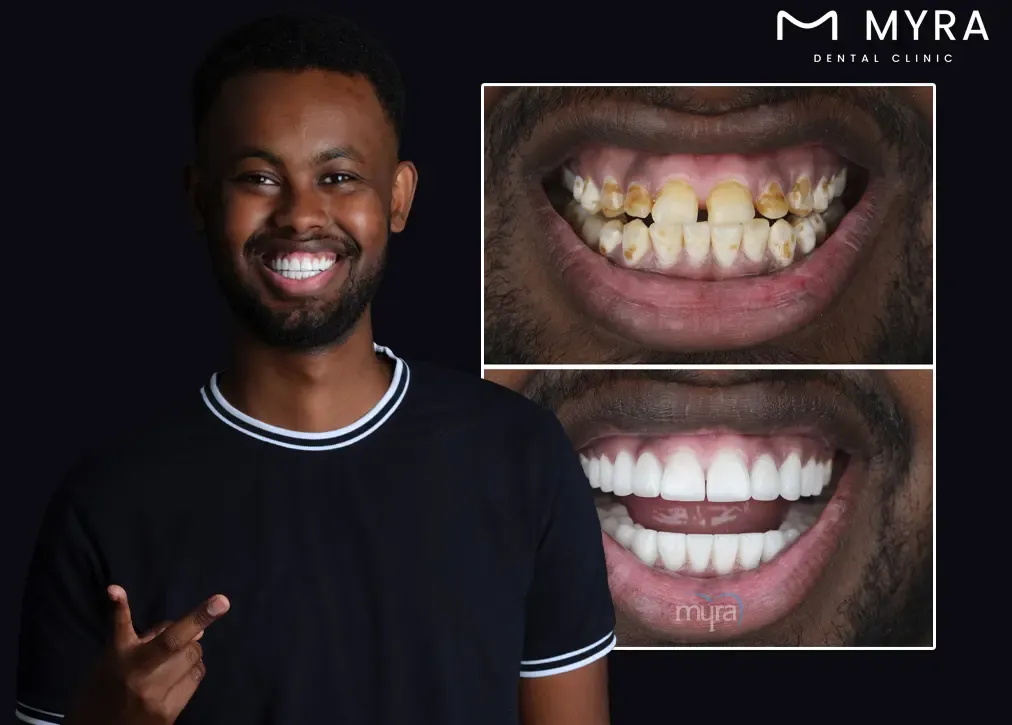
The situations in which Gum Contouring is preferred in Turkey are listed below.
Gum contouring treatment in Turkey is done by following the 11 steps listed below.
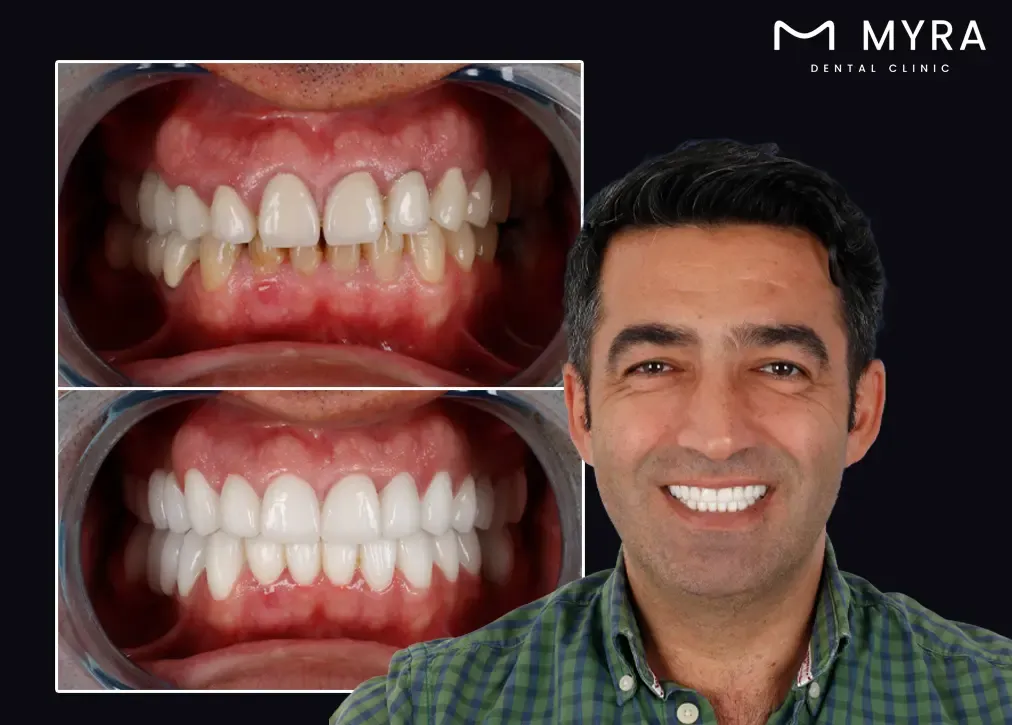
The gum contouring treatment takes 30 minutes to an hour in Turkey. Advanced tools such as soft tissue lasers or electrocautery are employed to achieve precise and efficient contouring results.
The duration of gum contouring treatment in Turkey depends on several factors, including the complexity of the case and the specific procedures involved. The entire treatment process spans approximately 3 to 6 months, offering a comprehensive approach to addressing gum-related concerns and enhancing oral aesthetics.
The initial phase involves an assessment and planning period lasting around 1 to 2 weeks. Dental professionals in Turkey evaluate the patient's oral health at the same time, discuss potential treatment options, and formulate a personalised plan tailored to the individual's needs.
Preparation and initial therapy follow, taking an additional 2 to 4 weeks. The phase addresses any pre-existing conditions, such as infections, ensuring that the patient is in optimal health before proceeding with the contouring procedure.
Postoperative recovery spans approximately 2 to 4 weeks, during which patients are advised to adhere to specific care instructions to facilitate proper healing. Regular follow-up appointments, scheduled over 3 to 6 months, play a crucial role in monitoring progress and addressing any concerns that arise during the recovery phase.
The complete healing and final assessment of the gum contouring treatment in Turkey extend up to 6 months. The timeframe allows for the stabilisation of the patient's gums and the manifestation of the desired aesthetic outcomes.
Individual responses to healing and the extent of gum-related issues contribute to the variability in the treatment timeline. Strict adherence to postoperative care instructions, coupled with regular follow-up appointments, ensures a successful and timely recovery. Patients undergoing gum contouring in Turkey anticipate experiencing the benefits within the specified timeframe, achieving improved oral health and enhanced aesthetic results.
The benefits of Gum Contouring in Turkey are listed below.
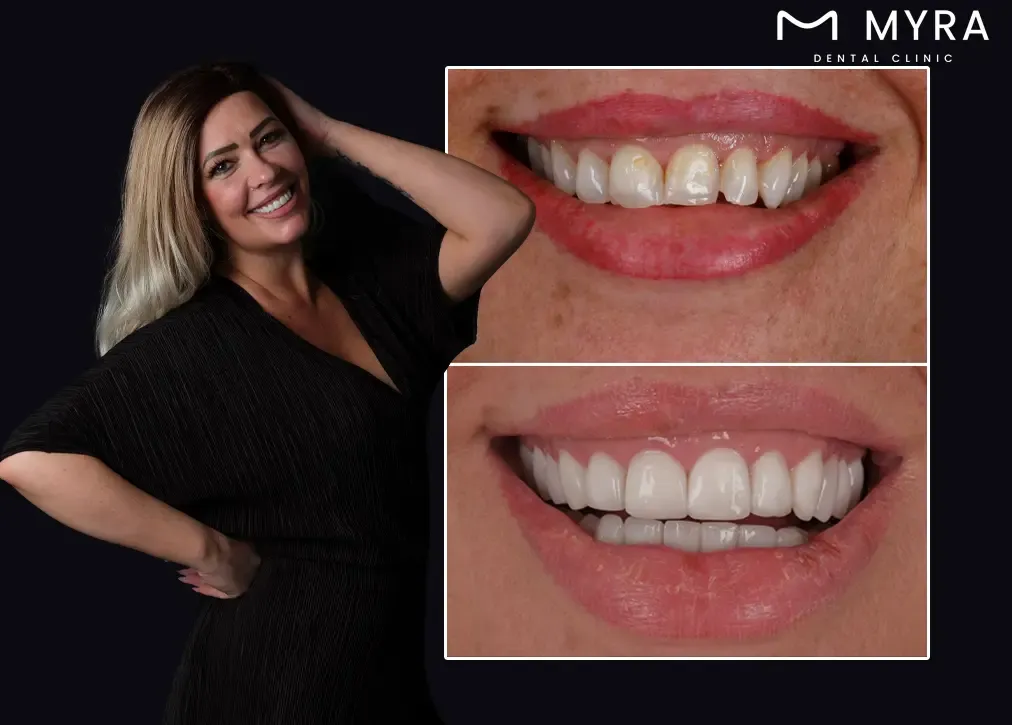
The downsides of Gum Contouring in Turkey are listed below.
Gum contouring is a dental procedure aimed at improving the appearance and oral hygiene of the gums and teeth by reshaping the gum line. The objective of gum contouring is to achieve a visually appealing smile by establishing a natural balance between the gums and teeth.
The procedure involves the removal of excess gum tissue that covers a portion of the teeth, a condition commonly known as a "gummy smile." The excess tissue affects the symmetry of the smile, making gum contouring an effective solution for achieving a more balanced and attractive appearance.
Gum Contouring is performed using specialised dental tools or advanced laser technology. Laser-based procedures have become increasingly popular due to their precision, reduced bleeding, and the ability to target specific areas with greater accuracy. The use of lasers removes excess tissue and seals the treated area, promoting faster healing and minimising post-operative discomfort.
One of the key benefits of gum contouring is its ability to address hollowed areas or pockets where bacteria accumulate. The bacterial pockets are minimised by reshaping the gums, reducing the risk of oral health issues such as gum disease.
Gum contouring contributes to a more balanced and visually pleasing smile from an aesthetic perspective. The procedure exposes more of the tooth structure, making the teeth appear longer and enhancing the overall facial aesthetic. The aesthetic improvement is particularly beneficial for individuals with a disproportionate gum-to-tooth ratio.
Gum contouring plays a role in slowing the progression of tooth decay beyond aesthetics. The removal of excess tissue makes it easier to maintain proper oral hygiene, reducing the risk of decay and associated dental problems. Gum contouring helps reduce the likelihood of periodontal infection recurrence by making the mouth's natural structure less supportive of the condition.
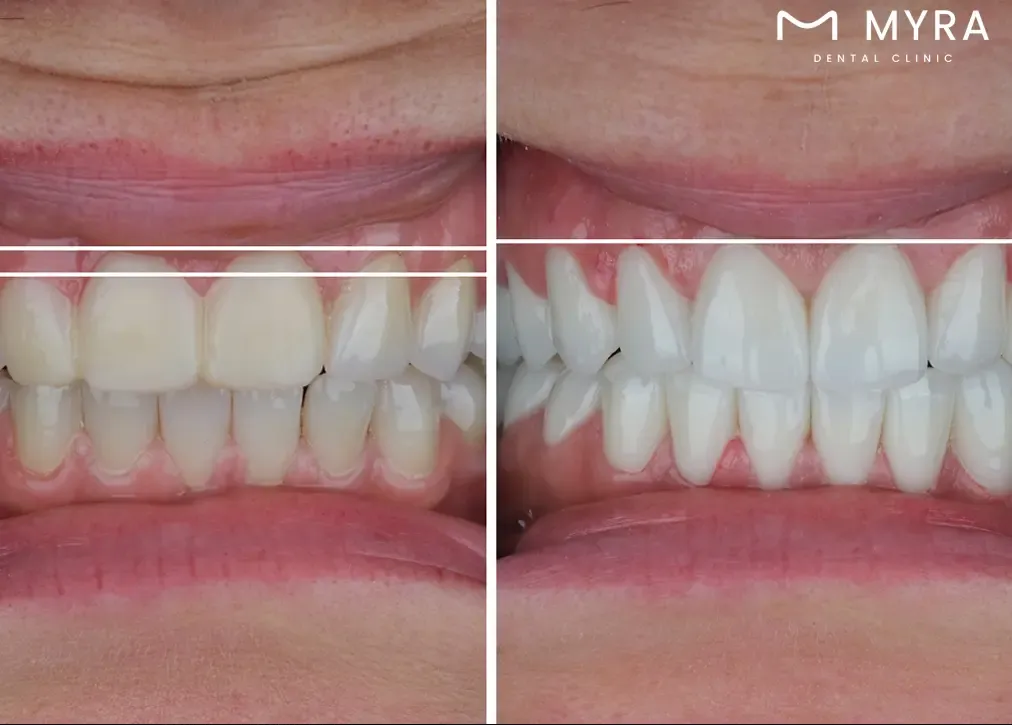
The types of anaesthesia applied in Gum Contouring in Turkey are listed below.
The Gum Shaping treatment methods in Turkey are listed below.
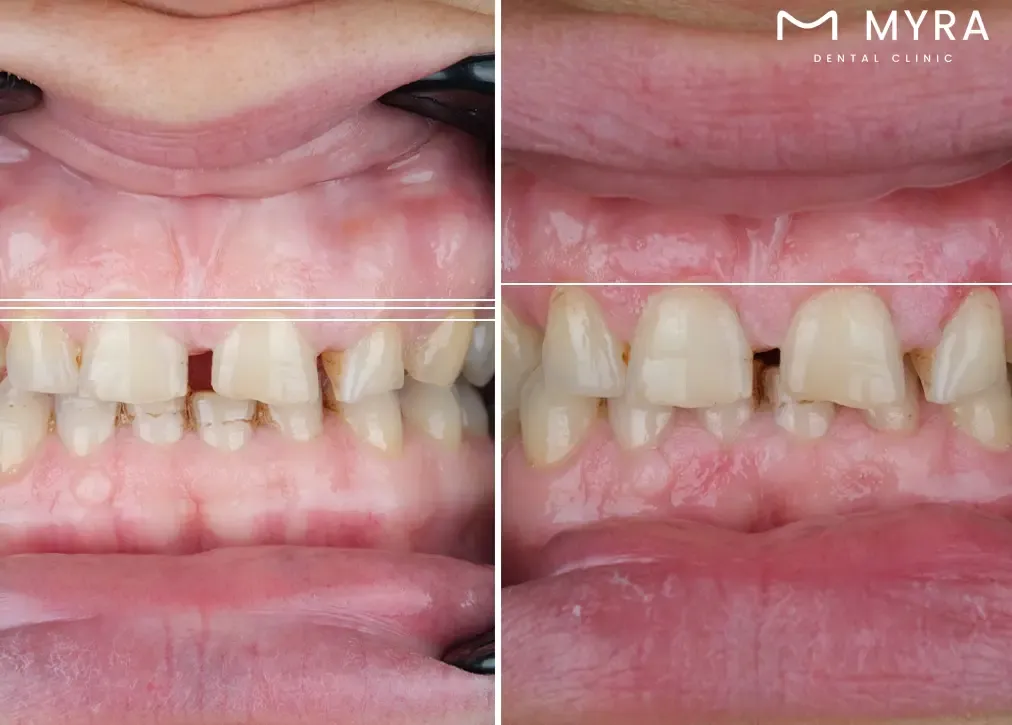
Laser gum reshaping is a cosmetic treatment that employs a unique dental laser to fix the gum line and enhance the aesthetic smile's overall look. The quick and nearly painless procedure consists of the gentle elimination of excess gum tissue to contour and shape the gums.
Laser gum reshaping is recommended for individuals facing various cosmetic and dental concerns. Laser is an ideal solution for individuals with an uneven gum line, individuals with a gummy smile, and people whose teeth appear smaller due to excess gum tissue. Laser gum reshaping is beneficial for individuals with teeth that seem disproportionate due to the gum line and people looking to reduce pockets caused by gum disease . It is a suitable option for individuals seeking to lengthen the crowns of their teeth to ensure the proper fit of veneers in Turkey and other dental restorations. The versatile treatment addresses a range of aesthetic and dental issues, providing patients with an effective solution to enhance their smile and oral health.
The dentist applies a fixed dental laser while performing the laser gum reshaping procedure. The laser is precisely controlled to shape the gums effectively and permanently.
The materials used in laser gum reshaping are minimal and primarily involve dental laser technology. The laser dentistry is designed to produce minimal trauma to the gum tissue and cauterise as it cuts, contributing to quick recovery and reducing infection risk.
The success rate of laser gum reshaping is high, with most patients finding the procedure to be nearly painless or minimally uncomfortable. The controlled application of the laser allows for precise gum contouring, contributing to successful aesthetic outcomes.
The cost of laser gum reshaping varies, with an average range of $675 to $875 per tooth in US and it costs $50 per tooth in Turkey. The total expense depends on the extent of the treatment needed and the individual's specific cosmetic concerns. Dental insurance does not cover the procedure because the procedure is deemed elective. Patients are expected to achieve a balanced and visually appealing smile through its effective and efficient treatment.
A bisturi, or scalpel, is a sharp, precision surgical instrument used in gum contouring procedures to make controlled incisions, allowing for the meticulous sculpting of gum tissue. Its purpose is to achieve precise shaping and symmetry in gum contouring.
Scalpels are recommended for individuals undergoing gum contouring procedures, particularly surgery requiring precise and controlled incisions for reshaping the gum line. Dental professionals recommend the method for cases where detailed work is necessary.
Ideal for cases where precision and versatility are crucial, bisturi or scalpel treatment is well-suited for gum contouring involving the removal of excess gum tissue, reshaping the gum line, and addressing uneven gum levels.
Scalpels are fixed surgical instruments designed for specific dental procedures. They are not removable during a gum contouring procedure, ensuring stability and precision throughout the process.
Scalpels used in gum contouring are made of high-quality metals, ensuring sharpness and durability. The materials involved do not include chemicals or drugs but are crafted to provide the necessary precision for incisions.
The success rate of gum contouring with a bisturi is high, especially when carried out by qualified dental professionals. The instrument's precision allows for effective and controlled reshaping, providing immediate and noticeable results in the gum line.
The cost of gum contouring with a bisturi varies, with a single session ranging from $200 to $400 in US and it costs $50 per tooth in Turkey, depending on the extent of the required contouring. Collective discounts are offered for multiple teeth. Gum contouring is a cosmetic procedure, and as such, insurance does not usually cover it. Always consult with a dental professional to determine the most suitable method and associated costs for individual cases.
Electrocautery, termed as electrosurgery, is a dental procedure that uses high-frequency electrical currents to cut or reshape soft tissues in the oral cavity. The technique is commonly employed for minimal reshaping, avoiding the need for stitches, minimising bleeding, and promoting rapid healing.
Electrocautery is recommended for patients requiring minimal reshaping of soft tissues in the oral cavity. It is suitable for cases where stitches are not necessary and rapid healing is desired.
Ideally used for cases involving very minimal reshaping, electrocautery is effective in contouring soft tissues without the need for extensive surgical procedures. It is suitable for patients seeking a procedure with minimal bleeding and a quick recovery.
Electrocautery devices are fixed instruments designed for specific dental procedures. They are not removable during treatment, ensuring stability and precision throughout the electrosurgical process.
The material used in electrocautery electrodes is metal, crafted for durability and effective cutting. The procedure does not involve the use of chemicals or drugs but relies on the application of high-frequency electrical currents to achieve the desired soft tissue changes.
Electrocautery exhibits a high success rate, providing effective soft tissue reshaping with minimal bleeding and rapid healing. The advantages of electrosurgery include cost-effectiveness, rapid cutting, and immediate hemostasis, contributing to its success.
The cost of electrosurgery ranges from $120 to $360 in US and it costs $50 per tooth in Turkey, depending on the extent of reshaping required and the specific dental practise. The procedure's affordability, along with its advantages, makes it a popular choice for dental professionals and patients seeking efficient soft tissue contouring.
The Gum Contouring materials are listed below.
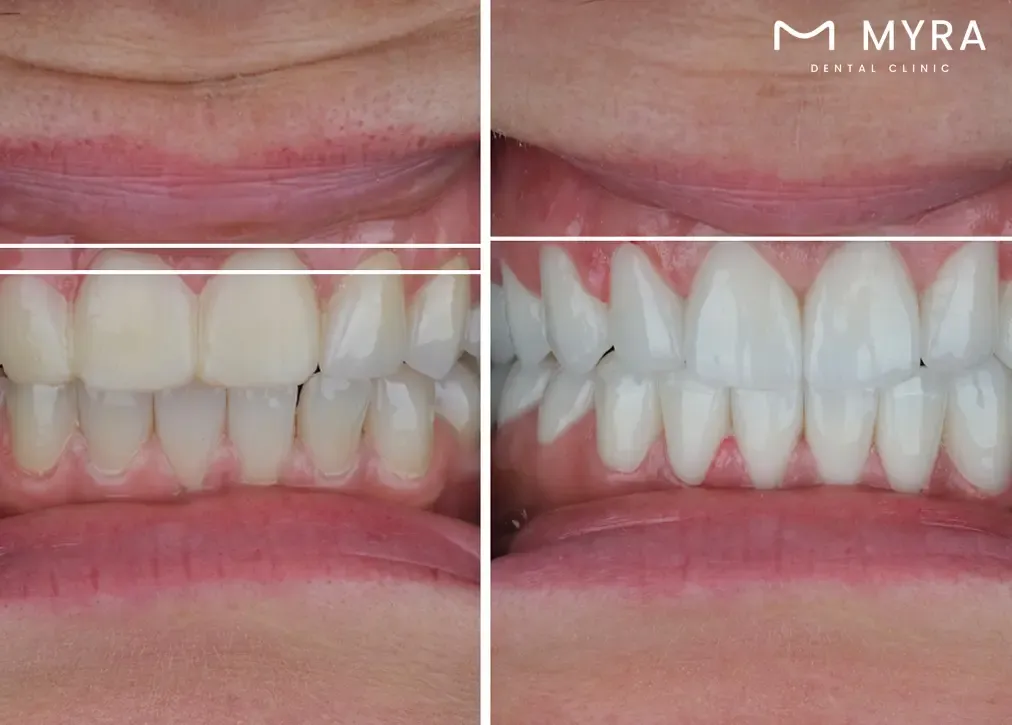
Gum contouring in Turkey is performed using specialised tools such as a soft-tissue laser, an electrocautery device, or a dental scalpel. The specific choice of instrument depends on the dentist's preference and the patient's individual needs. Needles and numbing gels are used to prepare the gums for cutting so that the patient does not experience any pain. Laser dentistry in Turkey accomplishes these procedures without the need for cutting. The use of a soft-tissue laser offers a precise and minimally invasive approach, helping to seal the tissue and reduce bleeding. The technology allows for better targeting of areas where excess tissue needs to be removed. Even small corrections to gum contouring give excellent results in some patients.
Gum contouring procedures in Turkey vary, and today's technological innovations have introduced many options in aesthetic dentistry. Bonding and lamination applications, for instance, are attached to anatomical structures such as teeth, enamel, and dentin, providing a long-lasting and aesthetic appearance. The gum contouring procedure is versatile, addressing severe gum diseases and often becoming essential for progressive conditions such as advanced gingivitis that affects the gums, tooth root, and jaw bone. Surgical operations become inevitable in such cases. Gum contouring is performed for oral and dental health preservation or aesthetic purposes, such as during gum shaping processes or to address gum recession. A comprehensive oral examination determines the necessary procedures, which must be carried out in a specific sequence to achieve a natural look on the gums and flawless prosthetic restorations in Turkey.
A good candidate for gum contouring in Turkey is an individual with concerns related to the positioning of their gums around their teeth, impacting the way their smile looks. Individuals who find their gums resting too low or too high on their teeth and are dissatisfied with their smiles benefit from gum contouring surgery. The cosmetic dental procedure known as gum reshaping or tissue sculpting is designed to address and correct such issues.
Gum contouring in Turkey proves highly effective in addressing specific cosmetic concerns related to the appearance of the gums and teeth. Gum contouring in Turkey helps people with "gummy smiles," which are caused by excessive gum tissue visibility. The procedure is designed to meticulously sculpt the gums, aiming for a more balanced and proportionate display that enhances the aesthetics of the smile.
Another common concern that gum contouring in Turkey addresses is an uneven gum line. It disrupts the harmony of the smile when the gums appear higher or lower in certain areas. Patients who suffer from an asymmetrical gum line have the option of having it corrected with gum reshaping. The procedure in Turkey involves precise adjustments to create uniformity along the gum line, contributing to a visually appealing result.
Gum contouring in Turkey is an option for braces-induced gum overgrowth. The procedure effectively addresses and corrects issues related to excessive gum tissue caused by orthodontic treatment, ultimately leading to an improved and balanced smile. The tailored approach of gum contouring allows for the enhancement of specific areas, ensuring a harmonious and confident smile that aligns with individual preferences.
Gum contouring in Turkey is a cosmetic procedure, and its necessity is driven by the desire to enhance the visual appeal of the teeth and gums. The procedure isn't always required by doctors, but it gives people a chance to get the smile they've always wanted.
People must talk to a dentist in Turkey before getting gum contouring so that the dentist has the information to figure out what problems they are having, how bad their gums are now, and what the results of the procedure are going to be. The personalised consultation ensures that the treatment aligns with one's own goals and expectations, leading to a more satisfying and confident smile.
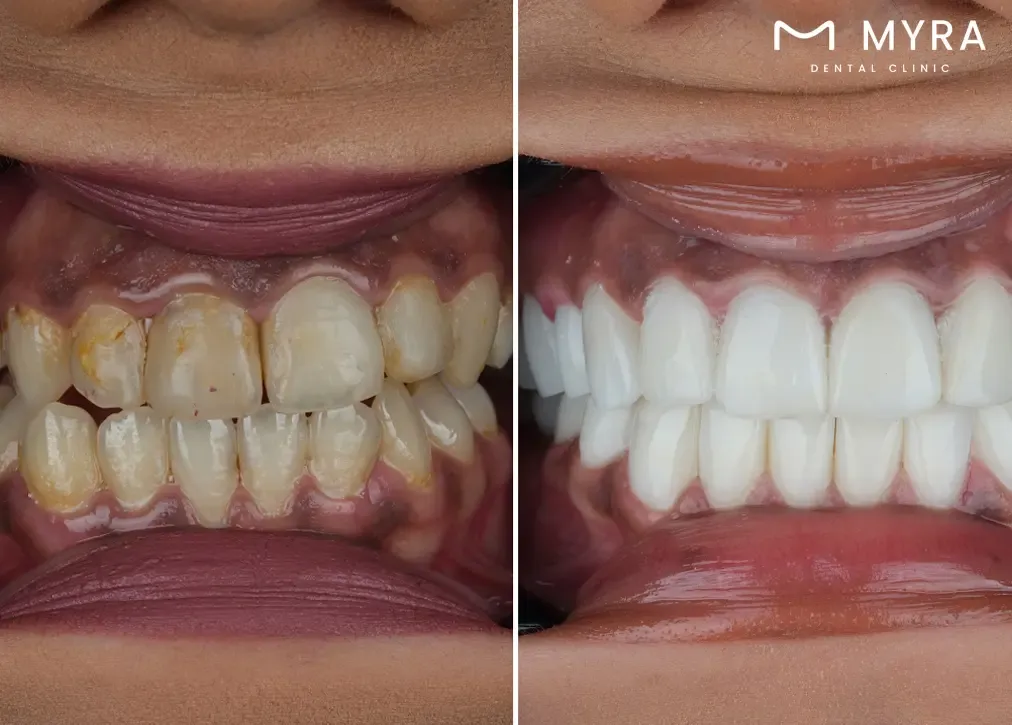
The patient must follow the correct protocol after the gum contouring procedurein Turkey to ensure optimal healing and minimise discomfort. The patient contributes to a smoother recovery process and achieves the best results from their gum contouring procedure by following these aftercare instructions. Get in touch with a dentist right away if there are any concerns or if the patient is experiencing any strange symptoms.
Gum contouring causes some mild soreness or discomfort at the treatment site. Over-the-counter pain relievers, such as acetaminophen or ibuprofen, help alleviate pain and reduce inflammation. Follow the dentist's advice on the appropriate dosage and frequency.
Mild bleeding at the gum contouring site is normal and usually subsides within a day or two. Gently biting down on a clean gauze pad or cotton ball helps control bleeding. Ensure not to disturb the treated area excessively to avoid prolonged bleeding.
Use soft and easy-to-chew foods during the initial days after gum contouring. It helps prevent unnecessary strain on the treated gums and promotes faster healing. Examples of suitable foods include yoghurt, mashed potatoes, soups, and smoothies.
Gently brush the teeth, avoiding the treated gums, to ensure cleanliness. Use a mild, alcohol-free mouthwash or a saltwater rinse as the dentist advises. Be cautious not to disturb the treated area excessively while cleaning to support the healing process.
The dentist in Turkey provides specific post-procedure instructions tailored to the patient’s case. Adhere to these guidelines diligently. It entails abstaining from specific foods, refraining from smoking, and attending subsequent dental sessions to oversee the development of healing.
The cost of gum contouring surgery varies widely, ranging from $50 to $350 in US for a single tooth or up to $3,000 for the contouring of all front top teeth in US. The figures serve as general estimates and actual costs differ based on the complexity of the procedure and the exact location.
Gum contouring, often pursued for cosmetic enhancements, is considered an elective procedure, indicating that it is not deemed medically necessary. Gum contouring is usually not covered by dental insurance. Individuals opting for the procedure must anticipate paying out of pocket. The cost fluctuates based on factors such as the extent of gum tissue removal or restoration and whether a specialist performs the procedure.
The materials used, the specific body parts involved, and the complexity of the procedures carried out all have an impact on how much gum contouring surgery costs. These factors contribute to the expense of the surgery, making it essential to understand their impact on the final cost.
The choice of materials plays a significant role in determining the cost of gum contouring. High-quality materials, such as advanced laser technology or specific dental tools, result in higher expenses. The types of materials used for reshaping, removing, or restoring gum tissue vary, affecting the entire cost of the procedure.
The extent of the gum contouring procedure, in terms of the number of teeth or specific areas involved, directly influences the cost. Treating a single tooth naturally incurs lower expenses compared to contouring multiple teeth or an entire arch. The more extensive the treatment area, the higher the associated costs.
The complexity of the gum contouring procedures performed affects the entire cost. Different techniques are employed based on the patient's needs, such as laser gum contouring, surgical removal of excess gum tissue, or nonsurgical options. Surgical procedures involve more intricate steps and necessitate the expertise of a specialist, contributing to increased costs.
Understanding the factors allows individuals to better comprehend the breakdown of costs associated with gum contouring surgery. People need to think carefully about all the costs and benefits before deciding to have the surgery because it is elective and dental insurance does not pay for cosmetic procedures.
The cost of gum contouring is $50 in Turkey for per tooth. Various factors contribute to the cost of gum reshaping in Turkey, allowing patients to understand the breakdown of expenses.
The choice of materials used during the gum contouring procedure significantly influences the entire cost. Advanced technologies, high-quality tools, and specific materials employed for reshaping or restoring gum tissue contribute to variations in pricing. Clinics offer different amenities, affecting the cost depending on the quality of materials used.
The extent of the gum contouring procedure, including the number of teeth or specific areas involved, is a key factor affecting the cost. Treating a single tooth incurs lower expenses compared to contouring multiple teeth or an entire arch. The cost increases with the scope of the treatment area.
The complexity of the gum contouring procedures performed plays a role in determining the cost. Different techniques, such as laser gum contouring, surgical removal of excess gum tissue, or nonsurgical options, have varying associated costs. Surgical procedures, which frequently call for specialised expertise, contribute to an increase in expenses.
Patients thinking about getting gum contouring surgery in Turkey shop around for the best deal in Istanbul at several reputable clinics. Dental treatment prices in Turkey attract patients from various parts of the world seeking cost-effective solutions. Patients must discuss the specific details of the procedure, including materials, body parts involved, and chosen techniques, with their chosen clinic to get a comprehensive understanding of the total cost.
How much does Gum Contouring Cost in Antalya?
The cost of gum contouring in Antalya is £40 per tooth but varies based on several factors and is performed for aesthetic and mandatory treatment purposes. Determining the cost of gum contouring involves considering various elements and the factors that influence the expenses associated with the procedure.
The particulars of the treatment affect how much gum contouring costs in Antalya. The cost depends on a range of factors, including aesthetic and legal considerations along with potential insurance coverage. The nature of the disease and the treatment method chosen are crucial factors impacting the fees associated with gum contouring.
The type and quality of materials used during gum contouring affect the entire cost. Advanced technologies and high-quality tools contribute to variations in pricing, and the choice of materials influences the effectiveness of the procedure.
The number of teeth or specific areas involved in the gum contouring procedure influences the cost. Treating a single tooth incurs lower expenses compared to contouring multiple teeth or an entire arch. The cost increases with the scope of the treatment area.
The complexity and type of gum contouring procedures performed impact the cost. Different techniques, such as laser gum contouring, surgical removal of excess gum tissue, or nonsurgical options, have varying associated costs. Surgical procedures, which require specialised expertise, contribute to an increase in total expense.
Contacting dental clinics directly is the best way to get the most accurate and current information about Antalya gum contouring prices. Myradental stands out by providing a more affordable option at £40 per tooth, emphasising the cost-effectiveness of their services. The total cost of gum contouring in Antalya is more easily understood by going over all the specifics of the procedure, such as the materials, body parts involved, and chosen techniques.
Things that should be considered after Gum Contouring in Turkey are listed below.